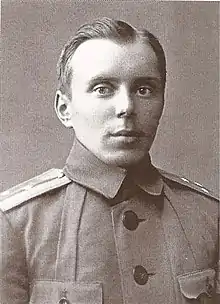Antanas Juozapavičius
Antanas Juozapavičius (13 February 1894 – 13 February 1919) was the first officer of the Army of the Republic of Lithuania to die while fighting in the Lithuanian Wars of Independence.[1]
Antanas Juozapavičius | |
|---|---|
 Antanas Juozapavičius | |
| Born | 13 February 1894 Švokštonys manor, Vaškai county, Russian Empire |
| Died | 13 February 1919 (aged 25) Alytus, Republic of Lithuania |
| Buried | Alytus cemetery |
| Allegiance | |
| Years of service | 1915-1919 |
| Rank | |
.jpg.webp)
Biography
Antanas Juozapavičius was born to Juozapas Juozapavičius and his wife Marijona Juozapavičienė. He was born in the small Švakštonys manor, which the parents were renting. As farming was financially unsuccessful, the family emigrated to Riga, where Juozapas Juozapavičius worked as a wagoner.[2]
In 1902, Antanas Juozapavičius started going to school in Riga, and from 1905 to Riga's Alexander II Boys' Gymnasium, although he was thrown out of school in sixth grade for the spreading of Lithuanian ideas. In Tartu, he educated to become a pharmacist, and from 1914 onwards worked as such in the pharmacies of Riga and Tartu.
World War I
After World War I started, in 1915 he enlisted as a volunteer of the Imperial Russian Army. After a few months he was sent to the Moscow military school, graduating as a Praporshchik, after which he was assigned to the 57th Infantry Regiment in Tver. In 1916 he completed the Gatchina machine gunner's school and promptly returned to his regiment.[1][2]
In the ranks of the Latvian Riflemen
In the end of 1916, on his request, he transferred to the 6th Tukums Latvian Riflemen Regiment,[1][2] as he knew Latvian. In the fights for Riga with Germans, he was injured and subsequently treated in Riga. He was awarded the 4th class of the Order of Saint Anna.
After the February Revolution
In 1917 June in Smolensk, after healing in the hospital, he was active in the committee for the organisation of Lithuanian military units.[1] On 26 November 1917, he was the commander of the 4th company of the Special Lithuanian Battalion and temporarily the commander of the Separate Lithuanian Battalion, which was disbanded on 15 March 1918.
Lithuanian Wars of Independence
Antanas Juozapavičius returned to Lithuania in June 1918. From 24 November 1918 he was the adjutant of the country's Defence Minister Augustinas Voldemaras. Later he was assigned to the 1st Infantry Regiment, which was moved from Vilnius to Alytus on 18 December 1918. When Jonas Galvydis-Bykauskas and Kazys Ladiga, who disapproved of the former's leadership, were removed from the regiment, Antanas Juozapavičius was made the temporary regimental commander on 4 February 1919.[3]
Death
He was wounded on the bridge of Alytus during the Battle of Alytus on his 25th birthday, when the regiment had to retreat for fear of encirclement, as the neighbouring allied German soldiers unexpectedly retreated.[4] However, Lithuanians quickly retook control of Alytus.[2]
Burial
He was buried on 14 February 1919 in the churchyard of St. Louis Church of Alytus. On 28 April 1919, he was ceremoniously reburied in the cemetery of Alytus, next to the St Guardian Angels Church of Alytus.
References
- "Antanas Juozapavičius". Penki ieškok (in Lithuanian). Archived from the original on 27 September 2007.
- "Antanas Juozapavičius – pirmasis karininkas, žuvęs už Lietuvą". XXI amžius (in Lithuanian). Archived from the original on 1 February 2014.
- Aničas, J. Karininkas Antanas Juozapavičius. p. 50.
- Juozapavičius, Antanas (2006). Visuotinė lietuvių enciklopedija. Vol. IX (Juocevičius-Khiva). Vilnius: Mokslo ir enciklopedijų leidybos institutas.
More reading
- Petras Biržys. Karininkas Antanas Juozapavičius, 1923 m.
- Karolis Dineika. Lietuvos karžygys Antanas Juozapavičius, 1926 m.
- Karininkas Antanas Juozapavičius, 1894 02 13 – 1919 02 13 (sud. Jonas Aničas). – 2-asis papild. ir patais. leid. – Vilnius: LR krašto apsaugos ministerija, 2004. – 124 p.: iliustr. – ISBN 9986-738-58-X
- https://luksas.wordpress.com/2011/02/11/karininkas-tapes-legenda/